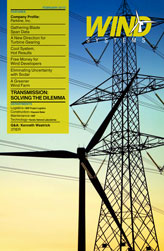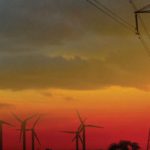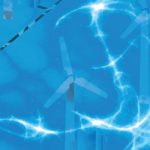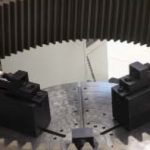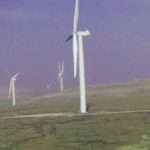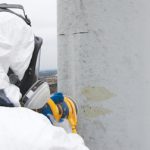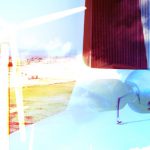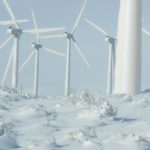I’m not a boundary layer meteorologist, nor do I have a degree in engineering, but I do possess something that makes me unique. I entered the wind energy industry believing that remote sensing was the standard. This perspective opened my eyes to the way things could, or should be. Before continuing I should point out that this article isn’t about remote sensing, per se, but the data that remote sensing and tall towers provide. My experience falls within the area of sodar.
Analyzing the Info
When I made the decision to enter the wind energy industry I left a field that analyzed historical data and used it to predict the future, so in many ways my transition seemed like a natural evolution. Wind resource assessment and next-day power predictions really are equivalent to what I’d done before, the data is just applied differently. The algorithms may not be the same, but the overall concept is identical: look at the past, predict the future.
My first task was to correlate met tower data to a remote sensing device. This was a fairly easy task. I simply took two sets of data—one from a 60 meter met tower, and the other from a sodar—and chronologically arranged them in an Excel spreadsheet. Using the handy chart wizard, I plotted several graphs. There were time series and correlations for every level. The time series appeared as though one set of data was lying right on top of the other. The correlation provided a linear fit with a slope of roughly .98 or .99. There was absolutely nothing special to note about this step of the process. Everything I saw was exactly as it should be, and the tower and the sodar matched well. They clearly were measuring the same regime, and the shears from level to level looked just fine. As I said before, up to this point the process was very uneventful.
After confirming that the mutual levels were in agreement, I was asked to look at the data at the hub height. Using every wind resource assessors’ favorite formula, u/ur = (z/zr)α —aka the power law—I took the met tower data and calculated hub height data for every single data point. Since the sodar collected data at the hub, I had no need to apply the law to that data set.
The extrapolated tower data projected higher wind speeds than that of the sodar. I really wasn’t too concerned. I figured that the formula was limited and was mostly designed as a model and not the rule. Since this was my first run, I consulted a meteorologist to confirm my results. Based on the terrain and location, I was told that this made perfect sense.
The site was questionable at best based on the sodar data, but it looked pretty good from the extrapolated data. So the client asked me to rework the data several times over. I really didn’t understand why. The data was pretty clear, but they were the client. I had several years of data, so I looked at specific years, then all of them together, and so on. I broke down the numbers by month and direction, and still the results suggested the same things. Eventually they decided to carry on with the project based on the extrapolated data, yet it was clear as day to me that it wasn’t a great idea.
Deriving the Data
I’m sure there were many internal factors that informed their decision. Maybe they proceeded just because they could get funding on the tower data alone at the time. I still don’t know the answer, but I do know that a financial organization shelled out investors’ money to develop a borderline site. Maybe tax credits would push the site into profitability, but there are definitely much better sites to consider for investment. This indifference to the actual hub height data inspired me to write this article. If I were a banker or a developer, I would want to know what is going on at the blades of a turbine since the technology exists that provides this data. I must admit that I can be a bit of a penny pincher, but wouldn’t you want to know everything about the wind profile before you write checks for millions, or even billions of dollars?
Review, for example, the chart shown in Fig. 1. The data is from two different sites. Notice that the two wind profiles are very similar up to the 70m mark, and almost identical to the 60m mark.
Site A is a site that follows the power law. The data has an R-squared value of 0.9982. Everything looks similar to what the extrapolation would suggest. There are many sites out there that fit this mold, and I am completely aware of this point. However, not all of them fit the bill. Site B is in a location without much in terms of complex terrain, but starting at 70m the shear begins to back off and eventually becomes a negative shear. These two sites will not produce the same amount of power. Actually, site B would produce less power since it has wind speeds close to 2 m/s less than that of site A in the blade swept area. Even worse, had the developer chosen to put up 100m hub height turbines, site B would dramatically under-produce based on the extrapolations. That is a fatal flaw with extrapolations. If there is a positive shear at levels with data, an extrapolation will predict that the wind speed increases the higher you go. As you can see from site B, this is not always that case.
Another strong example that I have seen firsthand is an onshore/offshore flow. The chart in Fig. 2 shows wind barbs that represent wind speed and direction. As you can see, the wind changes approximately 180 degrees around the typical hub height of a turbine. By looking at the 60m level and below—and in some cases 80m and below—this event would be missed. Onshore/offshore flows can be seen near coastal regions or near large bodies of water. While this particular image may be on the extreme side, wind-changing direction with height can be seen in numerous locations. In fact, I’m sure there are plenty of blooper reels with major league baseball players dancing around trying to follow a fly ball as it moves in the wind. Candlestick Park is probably featured in many of them.
Levels Don’t Lie
In other instances, this data can optimize wind farm construction. The chart in Fig. 3 shows a lower level jet in Texas. The terrain is very flat, with no complexities. Based on the information seen to the left, one can maximize the production at the site. As hub heights reach upward of 160m, this information can prove to be invaluable. How can one know if an 80m hub height is optimal in comparison to a 100m hub height, let alone a 160m hub height, without data at that level?
Quite often I find myself bewildered as I look at data. Isn’t it ironic that an industry so concerned with precision of instrumentation is willing to overlook the most crucial data; the levels that are actually generating power? I have sat through numerous conferences where anemometer A is analyzed versus anemometer B to whatever degree of accuracy in order to determine if they are precise enough to be used for wind resource assessment. Later, another speaker will face the audience and say that no matter how much data we collect, we cannot be 100-percent sure of the wind speeds for a given site next year—there are so many climate related factors that we can only tell if it is a worthwhile site for the long run, he will say. With enough data, we can at best predict an average yearly speed, but we still cannot precisely predict the wind speed on a year by year basis. While we try to determine what the wind speed will be at a given level within 0.01 m/s—even when we know it probably won’t be exactly the same next year—we are willing to overlook the phenomena that we know will happen annually: lower level jets, negative shear, onshore/offshore flows, etc. Talk about not seeing the forest for the trees.
I’m not suggesting that the precision of current instrumentation isn’t valuable, but it would seem that knowing the data in the blade span of a turbine is equally valuable, if not more so.
Complexities to Consider
With a worldwide push to move to green energy, wind farms are growing at an increasing rate. While it is exciting to be part of this, it also means the most obvious locations for farms have probably been developed, or are being developed right now. Future farms will encounter new terrain, and with that new complexities. The need for blade span data has never been so great, and this will only continue to increase. If you were writing the check, after all, wouldn’t you want blade span data?



















